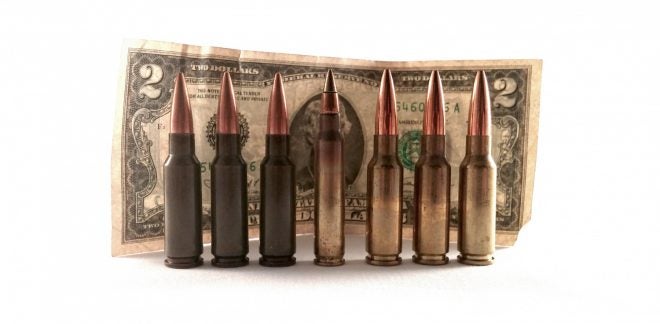This subject has come up in my comments recently, and I thought I would explore it in a post proper. To adopt the 6.5 Grendel (or, as we’ll see, something like it), the US Army would need to develop and procure new complete upper receivers, magazines, buffers, and possibly other small components, as well as the ammunition itself. How much would that cost? It’s impossible to say for sure unless it happens, but with a little napkin-math, we should be able to get some idea:
1. A new AR-15 upper receiver is about 2/3s the cost of a new rifle. The cheapest 6.5 Grendel upper receivers are about $600 on the civilian market (contrast that with the ~$650 unit cost for an M4), and a military variant still would need a full development and procurement program to ensure correct operation and parts life cycles in military service. If the Army committed to buying half a million new upper receivers at, say, $430/per, that would be a $215 million purchase, not including development costs. The costs to develop the 6.5mm upper receivers would likely run into the tens or even hundreds of millions; the XM8 rifle cost $33 million over its abortive development, and was based on an existing weapon. Many problems would likely have to be solved during this period, examples of likely ones being:
– Bolts for the new upper receivers are too weak for sustained military use, and need to be redesigned.
– The new bolts need to be made incompatible with legacy 5.56mm systems.
– A new buffer needs to be developed for reliable function on fully automatic with 6.5mm ammunition.
– A new barrel thread and flash hider need to be developed that are incompatible with legacy 5.56mm systems.
This development would likely incur costs of at least $50 million, meaning it would be approximately $300+ million to procure the new upper receivers, alone.
2. All of the old magazines would become obsolete overnight for operational units, and the new magazines would have to look sufficiently different to avoid confusion, while working reliably. Since no such magazines exist on the civilian market, a new development program for magazines would have to be conducted, which would likely cost millions of dollars. Procurement of the new magazines, if the prices were similar for 5.56mm USGIs, would be about $45 million for 5 million units. So, for magazines, that’s about $50 million.
3. No one is producing 6.5 Grendel ammunition in quantity. It uses a completely unique case head diameter among US military ammunition, and has a 30-degree shoulder which makes mass production tricky. In the late 1940s, engineers at Frankford Arsenal discovered that the experimental .30 Light Rifle ammunition with a 30 degree shoulder would be significantly harder to manufacture in quantity than ammunition with a less extreme shoulder. As a result, they changed the design, which eventually became 7.62 NATO, to have a less severe shoulder angle of 20 degrees.
This means that a whole development production for new 6.5mm ammunition, only loosely based on the 6.5 Grendel would need to be conducted. It took $32 million to develop the M855A1, which used a legacy case and primer, and an existing caliber and twist rate as well as a new but pre-existing propellant. This new caliber, which would not end up being identical to 6.5 Grendel, would need to have completely new cases, propellants, projectiles (ball, tracer, , twist rate, etc; every element but the primers developed from scratch. Cost would likely be at least $50 million. Plus, completely new ammunition would need to be procured alongside existing ammunition production, to maintain readiness. That would cost the USG approximately $350 million for a billion rounds (approx. yearly small arms ammunition production; M855A1 unit cost is about $0.31, but the new caliber uses more materials and would thus be more expensive), although some of that could be absorbed by the reduction in 5.56mm and 7.62mm ammunition procurement. So that would give a total combined development and procurement cost of about $300-$350 million.
In sum, to adopt the 6.5 Grendel, total development costs would be well over $100 million, and procurement costs well past the half a billion dollar mark. Overall, the program would likely cost close to a billion dollars altogether for development and procurement, combined.
Is all that worth it? Yes, if you have an ironclad case that the weight increase of the new round is offset by increased and meaningful effectiveness and a tangible advantage in firepower for the squad.
But that ironclad case doesn’t exist, yet.
 Your Privacy Choices
Your Privacy Choices
